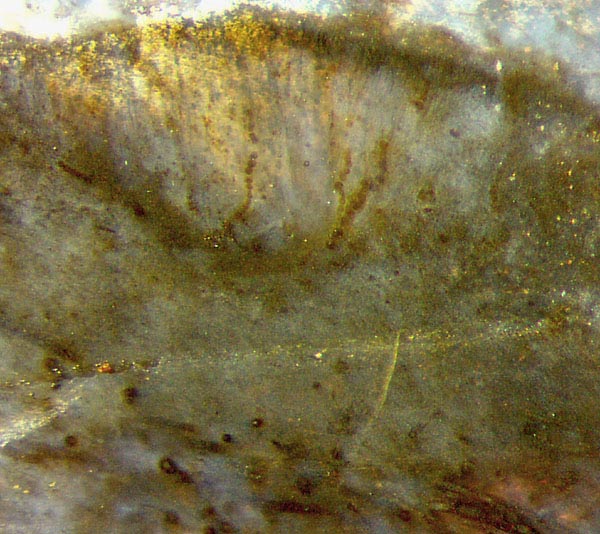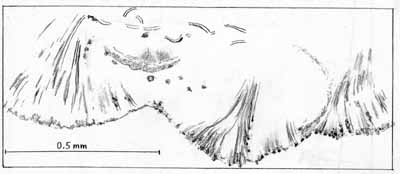Flat nematophyte - Details and
reconstruction

A recently found nematophyte resembling Nematophyton
taiti found in the Rhynie chert about a hundred
years ago [1] shows a few details from which a tentative reconstruction
can be derived. (See also Rhynie
Chert News 35.)
Since the nematophytes have not
yet been placed on a branch of the phylogenetic tree but go under the
haunting term Enigmatic Organisms [2], any new detail will be of
interest.
As explained before, nematophytes are made up
of tube-like filaments of two or more types, probably embedded in
organic gel
which keeps them together and keeps floating debris out.
The present
specimen shows three types of tissues in a wider sense (Fig.1). There
is an inner stratum with big tubes of about 20Ám diameter and probably
much smaller tubes, not seen here, in between. This inner stratum is
enveloped by a region with poorly visible smaller tubes
which mainly appear as scattered dark sections indicating
diameters of about 10Ám. Embedded in this outer layer there
are pockets of aligned tubes, often in a more or less
fan-shaped
arrangement, diverging towards the surface (Figs.1,2). Remarkable are
the
chains of dark dots apparently
generated in some of the tubes (Fig.1), with superficial resemblance to
ascospores of the ascomycetes.
Fig.1: Nematophyte from Rhynie chert,
half vertical section, middle stratum with big tubes below, outer layer
above, with pocket of aligned tubes, rows of dark dots therein.
Width of the image 1.1mm.

Fig.2: Three adjacent pockets of tubes aligned in a fan-like way in the
outer layer of the
nematophyte
specimen presented here.
Fig.3 (below): Tentative reconstruction based
on observed details of the flat nematophyte specimen
recently found in the Rhynie chert. Width about 3.5cm.

The reconstruction is based on a specimen which is not
preserved as a whole but as several fragments (in one piece of chert)
which seemed to have
belonged to a patch with a diameter of about 3.5cm. The
"branch
knots" seen among the big tubes in other nematophytes seem to
be less conspicuous here.
Although of no relevance to the present reconstruction, it is worth
mentioning that the tube sizes of several
nematophyte specimens from the Rhynie chert differ considerably. The
diameter of the aligned tubes is about 10Ám in
this specimen, about
20Ám in Pachytheca, and about 60Ám in the
specimen shown in Rhynie
Chert News 92.
It can be hoped that observations like the present
ones will gradually contribute
to a better understanding of the nematophytes so that they
eventually don't have to carry the epithet "Enigmatic Organisms" any
more.
Annotations 2020: The flat shape seemed to hint at a
possible connection with Nematothallus [4].
That idea is herewith retracted since a small lump of a nematophyte
which might be Nematothallus after
[3], preserved in 3D, has been found recently: Rhynie
Chert News 151. (Sorry,
Nematothallus
and Nematophyton
had been confused in the first version of the above text.)
Now that Nematophyton taiti
[1] has been re-named Prototaxites taiti [5], the
present specimen, too, may have to be reconsidered with respect to a
possible fungus affiliation.
More unknown nematophytes are compiled in Rhynie
Chert News 156 .
Sample: Rh2/7 (2.1kg), obtained from Shanks in
2000, Fig.1 taken from Part 6.
H.-J.
Weiss
2011 2020
[1] R.
Kidston, W.H. Lang: On Old Red Sandstone plants showing
structure ..., Part V,
Trans. Roy.
Soc. Edinburgh 52 (1921), 855-902.
[2] T.N. Taylor,
E.L.Taylor, M. Krings: Paleobotany, Elsevier 2009.
[3] P. K. Strother:
Clarification of the genus Nematothallus,
J. Paleont. 67 (1993),
1090-94.
[4] H.-J.
Weiss: Enigmatic Organisms - Insights
derived from new finds, Poster presentation, EPPC Budapest 2010.
[5] R. Honegger, D.
Edwards, L. Axe, Ch. Strullu-Derrien: Fertile Prototaxites taiti:
a basal ascomycete with inoperculate, polysporous asci lacking croziers.
Phil. Trans. Roy.
Soc. B 373 (2017): 20170146.
 |
 |
46 |






